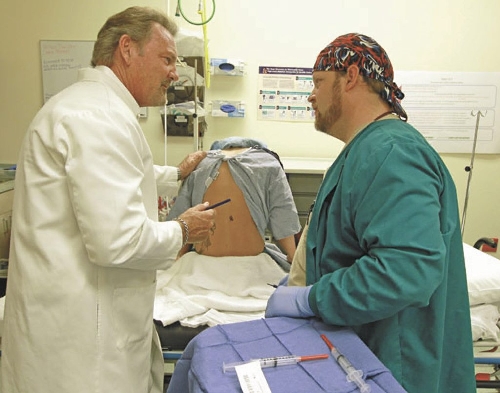Southern Nevada doctor part of effort to eliminate surgical errors


The real-life medical dramas in the operating rooms at Seven Hills Surgery Center in Henderson all begin with this commanding call-to-order from a nurse:
“LET’S START WITH A TIMEOUT.”
Then, when the only sound in the OR is the drone of medical equipment, members of the medical team stand near the patient and verbally go through a scripted checklist much like an airline pilot does before taking off.
The script is designed to combat so-called wrong-site surgeries: wrong patient, wrong procedure, wrong site or wrong side.
At one point, the nurse directs the surgeon and OR technician to actually touch the mark indicating where the surgery will be done on the patient’s body. At another point, the surgeon asks: “Can everyone see the mark?”
The entire team must respond in the affirmative before anything else is dealt with.
Near the end of the time-out script, the nurse asks: “Does the team have any concerns?”
If the answer is “yes,” they discuss solutions.
What goes on to prevent wrong-site surgeries at Seven Hills and seven other health care facilities across the country will be part a national news conference today by the Joint Commission Center for Transforming Health Care. Its project team has worked for a year on ways to cut back on an estimated 40 wrong-site surgeries per week in the United States.
In 2010, the Nevada State Health Division, working from sentinel event data supplied by health facilities, reported that three procedures were done on the wrong person and eight were performed on the wrong part of a patient’s body.
The health division’s Jay Kvam said they are suspicious of underreporting and misreporting sentinel events and said state officials are investigating the issue.
State officials can administer sanctions against a facility, including issuing fines of $100 per day for failure to report a sentinel event, if they should find out that one occurred.
Dr. Rudy Manthei, president and CEO of the Henderson center, has been a member of the Joint Commission project team. During the past year, Manthei analyzed the procedures at his clinic, and his staff was able to improve site marking for procedures and the time out protocol.
“A wrong-site surgery event should never occur,” said Manthei, who added he was honored that his center was asked to participate in a project that helps develop tools and processes shared with surgical providers across the country.
Standardized processes at health facilities can go a long way toward stamping out wrong-site surgeries, Manthei said.
While a timeout before surgery has been required for about six years by the Joint Commission, which accredits and certifies more than 19,000 health care organizations and programs in the United States, too often the exercise can become perfunctory, where only a few people in the OR actually participate.
“In this last year, we’ve worked to make sure everybody buys in,” he said. “We’ve had a timeout for years, but you need everybody to participate. You need it quiet and everybody focused on the checklist, nothing else.”
Manthei requires written documentation that the checklist has been followed.
“Every place must find a way to standardize their own processes for safety,” Manthei said.
The participating ambulatory surgical centers and hospitals in the Joint Commission project found that ineffective communication and distractions in the operating room weren’t the only things contributing to increasing the risk of wrong site surgery.
So were problems with scheduling and pre-operation processes.
Unapproved abbreviations, cross-outs and illegible handwriting used on booking forms can create mistakes, the project team found. To correct that, team members said relationships with physicians’ offices should be improved so that medical personnel know what is required for accurate information.
The team also recommended that a patient not be moved to the OR before:
■ The surgeon marks the operation site.
■ Identification of the patient is made by all team members using patient armband.
■ The patient provides information, or his caregiver does, should the patient be sedated.
Addressing documentation and verification issues outside the operating room decreased the chances of a procedure not going by the book from 52 percent to 19 percent, the project team found.
In operations where more than one procedure is performed, the project team suggested there be a pause before each procedure to ensure that each one is accurate and according to the site contained within the signed surgical consent.
Manthei, who will be called on by reporters throughout the country today in a news conference originating from Oakbrook Terrace, Ill., said he thinks that continually stressing safety will greatly bring down the number of wrong site surgeries.
“It has to be a continuous thing,” he said. “What surprised and gratified me was how responsive surgeons were to becoming part of the process. Surgeons tend to be resistant to change, but once they became educated on the process, they not only embraced it, they became team leaders.”
Contact reporter Paul Harasim at pharasim@review
journal.com or 702-387-2908.












